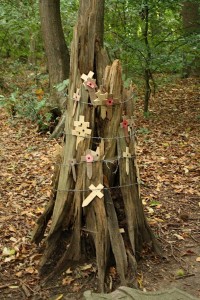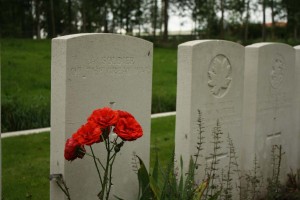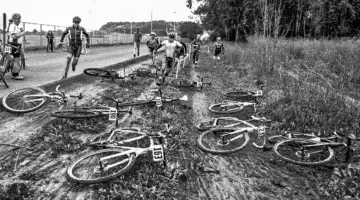
The trunk of a tree near Sanctuary Wood that was destroyed by an artillery shell during WWI © Dan Seaton
by Dan Seaton
Dulce et Decorum Est
A few weeks ago I took a weekend off from racing to drive out to Ieper – sometimes better known by its French name, Ypres – with my wife, Mindi, and her aunt and uncle, who were visiting us here in Belgium. It was a nice break from my regular schedule of racing or writing about racing nearly every weekend, and it was a chance to finally see the remaining trenches and craters and cemeteries from World War I that I’ve been meaning to visit for a long time.
The trip has stayed with me since then, and what we saw there resonated especially today, when I found myself once again running through the mud in the pouring rain, racing while Belgium celebrated Armistice Day, the day that marked the end of a war that cost this country dearly.
For ’crossers and ’cross fans, the words Flanders and mud resonate, and are used together with some reverence. Flemish mud is something special, something that can change a hard day into an impossibly hard day, an ordinary race into a legendary epic.
But for anybody who survived Belgium during the First World War, the mud of Flanders must have had a different resonance. The mud of Flanders defined the order of battle along the northern part of the Western Front throughout the war, strangling troop movements, defining the terms under which attacks could be carried out and matériel could be transported to the front lines, and setting up the fight of attrition that left nearly a million soldiers in Flanders dead. The dead included some 500,000 in the Battle of Passchendaele alone, a single engagement fought over the course of three months in 1917. More than 50,000 Commonwealth troops simply disappeared from the face of the earth, lost forever under millions of tons of the same Flemish mud that ’crossers celebrate now.
During the Battle of Passchendaele in particular, the mud was a decisive factor. The summer of 1917 was cold and wet and, after heavy artillery completely destroyed everything within a few kilometers of the front, the rain on the ruined land turned everything to thick, impossible mud. In order for troops to make their way to the front, soldiers moved on narrow boardwalks on top of the muck. Soldiers who fell, already weighed down by heavy clothes and more than 100 pounds (about 45kg) of gear could get stuck. Fall into a water-filled crater and you could drown before anybody even noticed you were gone, let alone had time to help you. The ground sometimes simply liquefied, swallowing trucks and tanks and troops; the bodies of soldiers buried after the First and Second Battles of Ypres occasionally floated up to the surface again.
Here in Flanders we complain when the mud clogs our bikes, snaps derailleurs, sucks our shoes from our feet, but it’s worth remembering: the mud here also has a different meaning.
One cold, rainy afternoon in January, I found myself standing knee-deep in mud in Langemark, not far from Ieper, trying to get my bikes and my clothes clean. The day was miserable, and my race had been a miserable race, and I was thinking about how entirely miserable I was just to be there when I noticed a small cemetery, a handful of German graves from the First World War, across the street. The cemeteries here are haphazard, small numbers of soldiers buried close to where they fell, in a hurry, before the artillery began to rain down again. I looked at the cemetery and I looked at myself; thought about the young men – far younger than I – who spent a year living in the muck, waiting, interminably, inevitably, for the mortar with their names on them. I thought about the missing, still waiting, more than 90 years later; forever waiting under a thousand tons of mud.
I asked myself, is it appropriate to race a bike, to celebrate our being alive, on fields built on the unmarked graves of unnamed thousands?
It is, I finally decided. Dulce et decorum est. It is sweet and fitting: we honor the dead by continuing to live. So pedal your bike, revel in the mud, but don’t forget its past.





























